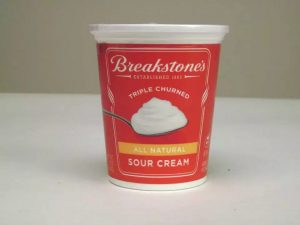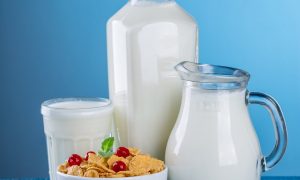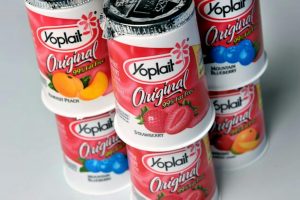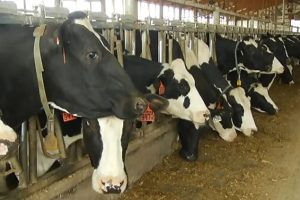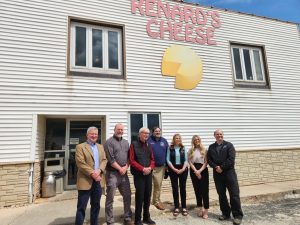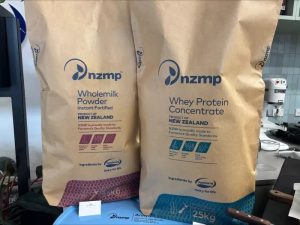
Averdant field, gently rolling. Blue sky. A brown Jersey cow with velvet ears, mowing through grass.
Bucolic imagery sells milk in America. In Oregon, these scenes dot Willamette Valley bottomlands all the way to the coast. In Tillamook County—dairy country—tourists at the Tillamook Creamery Visitor Center dip fried cheese curds in ranch dressing and locals root for the Tillamook High Cheesemakers. The Tillamook County Creamery Association, founded in 1909, is one of the oldest continuously operating dairy cooperatives in the world.
For 175 years, lactose has been close to Oregon’s heart: ingested in tall, frothy glasses of our state drink and exported as ice cream, yogurt, and bricks of cheddar. Dairy is Oregon’s fourth-most-valuable commodity, right behind hay, beef, and nursery products like Christmas trees.
But small dairy farms are a dying breed in today’s climate, even as our milk exports soar. That’s largely thanks to the new megadairies located east of the Cascades in Oregon’s drought-stricken high desert, which rank among the globe’s largest. Megadairies are driving up global milk production—as well as the methane-emitting manure reservoirs that come with these industrial systems.
In Oregon, the consolidation of this once-cottage industry has been abetted by historically friendly regulators. As an unmistakable link between cattle and climate change emerges, these tensions are fueling a knock-down, drag-out fight over the economic and environmental cost of milk.
One start-up says it has found a better way. Portland-based Neutral Milk claims to be the world’s first carbon-neutral food company. And for $5.49 a half-gallon, it promises—right on the carton—that we can all fight climate change.
“We don’t want to be preachy, and we don’t want to sell a happy cow image,” says Marcus Lovell Smith, Neutral Milk’s CEO. “We’re in dairy because if you’re going to make agricultural transformational change, you have to do it with animal proteins and animal products.”
It all sounds very slick for the industry that once banked on the milk mustache. But increasingly, interests both in and outside the Oregon dairy community agree that for this heritage industry to survive, it has to change. Starting with all the shit.

Neutral is the kind of data-driven “technology-agnostic” business global investors love. Bill Gates already does. Last November, Gates and fellow billionaire Mark Cuban together sunk $4 million into Neutral Milk; in April, the company announced a second round of funding from celebrity investors, including musician John Legend, model Emily Ratajkowski, and NBA stars LeBron James and Kevin Love, a Portland native. It’s scaling fast in national markets like Whole Foods, while also upping its local profile. (Your Fifty Licks ice cream and Stumptown cappuccino are both made with Neutral Milk.)
According to the United Nations, food systems account for about 34 percent of global greenhouse gas emissions; dairy and beef production drive much of that. Neutral Milk has done the math on its own impact, with an assessment spanning hay fertilizer to your milk run years later. By its calculation, it took 12 pounds of carbon to make that half-gallon of organic whole milk in our grocery tote.
All of which makes for a very good question for Neutral Milk’s CEO. If dairy is such a problem industry, why enter the space in the first place? Why not invest Bill Gates’s millions in making a highly disruptive filbert milk?
Before the last five or so years, we didn’t know what was really important—whether that was turning the faucet off while we’re cleaning our teeth or eating a hamburger or hopping on a plane or not. Now we know what are the real [climate change] contributors. —Marcus Lovell Smith, CEO, Neutral Milk
“Scale is important,” says Lovell Smith. “Otherwise we’re just fiddling around. Before the last five or so years, we didn’t know what was really important—whether that was turning the faucet off while we’re cleaning our teeth or eating a hamburger or jumping on a plane or not. Now we know what are the real [climate change] contributors.”
Nut and oat milks are great, he says, but these plant-based options haven’t changed the fact that roughly 92 percent of American households still stock dairy products. Increasingly, those households can buy Neutral Milk’s own products via a growing number of stores, including Target, Sprouts, and New Seasons. On shelves, the cartons are hard to miss: bright yolk-yellow with that bold climate-change-fighting tagline.
Right now, Neutral Milk’s way of fighting climate change means buying lots of carbon offsets. Offsets are credits, ideally verified by accredited auditors, purchased to ensure that a company’s own emissions are zeroed-out by reductions elsewhere—such as those created by the growing number of anaerobic digesters making “renewable” biogas from cow poop.
But offsetting at its best is simply a no-harm strategy—the warm-up act to a climate headliner. That’s why, according to Lovell Smith, Neutral Milk’s real ambition is to radically reduce emissions on the farms it works with directly.
Two years ago, the company hired Ann Radil, a former NASA-funded climate scientist from Wyoming, to roll out carbon reduction projects on its partnering dairy farms in Oregon, Washington, and some eastern US states.
Neutral Milk is investing multiple millions of dollars to launch 80-some of these projects over the next few years, says Radil. Neutral Milk’s involvement depends on the individual farms it works with: sometimes just writing the check to electrify a formerly gas-powered farm, sometimes providing the third-party monitoring to track a project’s impact for years to come.
“A farmer is not going to take on the really arduous task of monitoring increased carbon in trees through a riparian restoration,” says Radil.
One flagship early example is a $50,000 investment Neutral Milk made this spring in a manure separation project at a 200-cow dairy outside of Portland. Soon, Radil says, this dairy will be supplying high-quality compost to Portland gardeners: an extra revenue source for the farm, one that she claims can also mitigate the carbon footprint of 1.6 million half-gallons of milk.
Many of the projects Neutral Milk plans to roll out in the next few years fall in the tried and true category: actions with well-known environmental payoffs. These include manure composting, tree planting, and overseeding a grazing pasture with tannic greens that aid cows’ digestion. Many are also practical, like helping a farm acquire the equipment needed to use its own manure to fertilize distant hayfields, rather than buy fertilizer shipped from, say, Russia.
But Neutral Milk’s toolkit also includes what Radil calls more innovative strategies: things like feeding cows methane-reducing seaweed supplements. And some harken back to the good farming practices of time immemorial, like adaptive grazing, a fancy term for moving your herd around before it eats all the grass, thus conserving both rootbound carbon storage and soil health.
“If you time-stamp us now, we’re relying on offsets,” says Radil. “But we have a line of sight to be carbon neutral solely from our on-farm investments—to completely eliminate the carbon impact of our milk and half-and-half—very quickly.”
To get there, Neutral Milk needs to grow its portfolio of farm interventions at roughly the same pace that it expands its business. Radil says as long as farmers want Neutral Milk’s help, there will be project options; no dairy she’s seen yet is close to a zero-impact farm.
It helps that Neutral Milk’s partner farms have some land to work with. Right now, all of the company’s milk is certified organic, per federal standards that include the stipulation that cows spend at least 120 days outside, grazing on actual pastures. That means organic farms must have enough acreage to feed their whole herd during grazing season. Land prices are high, which often leads to the kind of smaller operations—the average herd size of a Neutral Milk supplier is 150 cows—that have traditionally been the beating heart of rural farming communities.
Which prompts another issue: while the small, organic farms might present endless, incremental opportunities for improvement, they’re also increasingly squeezed. In Oregon’s near future, it’s possible that there simply won’t be enough of them left to keep Neutral swimming in milk.
Lovell Smith is clear about ambitions to aggressively scale its dairy operation. He also says the company will be moving beyond milk. And every new product will reset the clock on Neutral Milk’s total carbon footprint: a gassy ouroboros trying to eat a tail that keeps growing larger.
“We’ll be a little shy on the details here, but we will be moving into other food staples,” he says. “Because the more products we sell, the more projects we can do on farms. And we need to do as many projects as possible.”
It also needs fellow travelers. A few do exist, beyond the world of half-and-half. New Belgium Brewing has a carbon neutral beer, and Kroger, the grocery giant that owns Fred Meyer, has launched a carbon neutral egg.
But Neutral Milk is hoping to start a movement across the food world. And if there’s a future for dairy done right—to crib a Tillamook tagline—then wouldn’t it be great if that movement started here, in Oregon dairy country?

The dairy lobby in Oregon is proud of that pastoral, small-farm image it has cultivated, even as behind the scenes it has pushed hard for hands-off regulations on larger agribusiness, and often succeeded.
“The advertising and packaging that Tillamook has put out makes it seem like they are all supplied by small, independent family farms that are letting their cows graze on the beautiful grasses of the Oregon coast,” says Amy Van Saun, a Portland-based attorney with the Center for Food Safety, a national consumer advocacy group.
“The reality,” she continues, “is that some 80-odd percent of their milk comes from Threemile Canyon in Boardman, which has such high ammonia emissions that you can see them from space.”
In dairy farming of yore, someone had the thankless job of collecting patties from pastures for use as fuel or fertilizer. A 1,400-pound dairy cow produces about 120 pounds of manure a day, meaning that barn cleaning is a big task for any dairy farm. But despite the rising popularity of organic milk, the majority of American dairy cows still spend much of their time inside: in the contained animal feeding operations, or CAFOs, that produce our conventional milk. For CAFOs, you have to move poop en masse, usually by flushing it into lagoons with water.
In Oregon, a large dairy is defined as anything above 700 head; Threemile Canyon currently runs a herd of at least 33,000 cows—meaning it generates the sewage equivalent of a small city in a considerably smaller space.
“It doesn’t matter whether you’re a teeny dairy or a giant dairy,” says Robert Parkhurst, an agribusiness consultant with California-based Sierra View Solutions. “As the book says, everybody poops. You gotta manage that poop, and get it out of there. It’s in the design of those systems that you have the opportunity.”
Manure management is a big issue for dairies worldwide, and not just because spills from CAFO lagoons and other storage systems can foul rivers and drinking water. (In Tillamook County, the dairy industry has been specifically called out by federal agencies for contributing to chronic water contamination, while Morrow County, home to Threemile Canyon, is within a special groundwater district monitored by the Oregon Department of Agriculture for high—and rising—nitrate levels.)
According to a November 2021 report by the United Nations Food and Agriculture Organization, cattle contribute more to man-made global greenhouse gas emissions than any other livestock animal, by far. Together, beef and dairy cow production make up 5 percent of the carbon dioxide, 44 percent of methane, and 53 percent of the nitrous oxide that humans pump into the air each year. One dairy cow, to put it crudely, is the emissions equivalent of a car.
Roughly 75 percent of those emissions come from manure and enteric fermentation—cow burps. And like the size of dairy herds, that gassy stat isn’t trending down, despite the G20’s most heartfelt climate pledges. Only deforestation, the UN recently calculated, now outpaces livestock manure in releasing the greenhouse gasses warming our planet. And some of that actually traces back to cattle, in clearing ever more land for pasture.
In the last three decades, the actual number of licensed dairies in Oregon has dropped from around 500 to 192 in 2020. On average, Oregon has been losing about six dairy farms a year.
If this trend holds, then we face a self-reinforcing cycle: more Oregon dairy farmers retiring or priced out of the business, and even fewer potential successors that can meet the costly barriers to entry. For Neutral to grow its movement here in this scenario, it would likely have to raise prices, or scale up the size of its suppliers.
Yet scaling up is what’s brought Oregon to the precipice of our current crisis.
“A lot of the products we have on the shelves are artificially cheap because we’re not making large food companies pay the costs of the way they do business,” says Tarah Heinzen, a Portland-based attorney with Food and Water Watch. “What we should be doing is making these companies address these problems.”
Making companies bear the full costs of things like greenhouse gas emissions and groundwater contamination would probably raise the price of products on shelves. (Price check: a half-gallon of 100 percent grass-fed Maple Hill milk costs $8.79; a half-gallon of conventional Grade A Alpenrose at the same store is $3.29.)
But in Oregon, she argues, we’re already paying a heavy price for cheaper milk. Heinzen and Van Saun say that if Oregon continues to embrace megadairies, those costs will escalate.
Oregon is becoming a magnet for extractive factory farms, says Van Saun, citing our lack of air quality regulation, unlike California, Washington, and even Wisconsin, and what she says is an unusually cozy relationship between dairy interests and regulatory agencies like the Oregon Department of Agriculture.
That’s a concern for her organization, which fiercely opposed the permitting of Lost Valley Farm, a 30,000-cow operation that briefly supplied Tillamook Creamery as Oregon’s then-second-largest megadairy, and Threemile Canyon’s neighbor.
In 2017, Lost Valley collapsed under the weight of more than 200 environmental violations and a prostitution sting that transmogrified into a bizarre, meth-addled bribery, gambling, and ultimately bankruptcy scandal for then-owner Greg te Velde, a recent California transplant. Cleaning up after Lost Valley cost Oregon taxpayers at least $325,000. Last year, Tami Kerr, then the executive director of the Oregon Dairy Farmers Association, told Oregon Public Broadcasting that the fiasco had given the whole dairy industry a “black eye.”
In a narrow sense, Van Saun’s coalition won that fight. They did not, however, win the larger battle. Twice now, in 2018 and 2021, the coalition has brought legislation asking for a “megadairy moratorium”: a pause on permits for new dairies or facility expansions involving more than 2,500 cows. And twice now, that proposed legislation has died on the vine.
Policies like these take time, says Alice Morrison, organizational director of the Oregon trade advocacy group Friends of Family Farmers. (FoFF’s membership includes both smaller Grade A dairy farms and producers of organic and raw milk.) Moratorium is a scary word, she admits, and her coalition has struggled to convince lawmakers beyond the bills’ main sponsors—Sen. Michael Dembrow and Rep. Rob Nosse, both Portland Democrats—that their bill doesn’t want to put anyone out of business.
In testifying against these bills, Tillamook and other larger dairy advocacy groups cautioned against creating new “headwinds” for farmers, particularly in reaction to “one bad actor.” The Farm Bureau took a harder tack, labeling the bills both “anti-farm” and “anti-business.” The pushback has so far worked, but Van Saun and Morrison are planning to bring the legislation back when lawmakers reconvene next January.
In the meantime, they’re waiting for state ag department’s next big decision: whether to allow Lost Valley to reopen under the ownership of Easterday Farms, a beef ranch based in Pasco, Washington. (Easterday made its own headlines last winter for a wild scheme to defraud Tyson Fresh Meats.)
“The state has been relatively welcoming to very large, industrial dairy farms,” says Morrison. “And that’s changed the structure of the system. The farms we work with don’t begrudge people making a living, but those milking maybe only 100 cows have a lot of trouble making ends meet.”
A moratorium would give Oregonians a chance to reconsider what Morrison describes as a dangerous trend: the consolidation of milk production among a few, deep-pocketed dairy owners, who can afford to sell their product cheap to Oregon creameries like Tillamook and DariGold—the cooperatives that process and pasteurize the bulk of Oregon’s conventional (nonorganic) milk.
Megadairies can literally flood the market, says Morrison, driving out smaller players and escalating a system in which only other megadairies can compete. And that sort of monopoly of power can lead to outsize political influence.
Oregon’s dairy industry has always enjoyed political clout, says Food and Water Watch’s Heinzen. For starters, it’s politically risky to be seen as anti-farmer in a proudly agricultural state.
Case in point: “Why do some legislators appear to be so anti-farmer?” former State Sen. Betsy Johnson asked Oregon Farm Bureau convention-goers last December, according to the Capital Press. “Being told climate change is the most important issue our nation faces rings hollow when you’re struggling to make it to the end of the month,” she continued.
The dairy industry has many champions on the right side of the aisle; Oregon’s rural voting districts are redder than a seascape strawberry in July. But the industry has long had a not-so-secret weapon in Johnson, a former Democrat who left the party last year and is now unaffiliated, with a decades-long history of supporting agricultural interests, as befits a representative of the coastal 16th District.
Johnson, the longtime cochair of the powerful Ways and Means Committee, a lifelong Oregonian, and child of a lumberman, has voted against bills to expand clean energy and improve groundwater monitoring. In 2019, she was one of three Senate Democrats responsible for derailing Gov. Kate Brown’s cap-and-trade bill: legislation that would have required energy producers and importers to offset their greenhouse gas emissions (much like Neutral Milk is doing)—new costs that some speculated could trickle down to consumers at the pump or grocery store.
Thanks to Johnson’s unusual-for-a-Democrat track record, she enjoys a 41 percent score from the Oregon League of Conservation Voters—and a 100 percent rating from the Oregon Farm Bureau, a ratio opposite that of many in her former party. The Farm Bureau is one of the most powerful lobbying entities in Salem, one that opposes policies aimed at farms that would mandate buffer zones between rivers and farmland, greenhouse gas emission reporting, and anything beyond voluntary, self-reported compliance with the federal Clean Water Act.
“Everyone in the Capitol knows that Betsy loves her dairy farmers,” said Oregon Dairy Farmers Association president Chad Allen in 2017, as quoted by the Tillamook Headlight Herald upon the occasion of presenting Johnson with the group’s Distinguished Service Award.
This year, Johnson is also running for governor: a surprise partyless candidate at a time of profound voter disenchantment with mainstream politics. Both early polling and fundraising momentum suggest she might even have a chance—if not of winning, then of splitting the ticket, perhaps to Republican advantage. At presstime, Johnson’s campaign had raised more than $7 million—more than any other candidate—including $1.75 million from Nike cofounder Phil Knight.
(It’s worth noting that Johnson hasn’t, in the past, pulled in the same level of sweet Farm Bureau funding as Republican colleagues like Christine Drazan, who is the Republican party’s gubernatorial nominee. By early May, Johnson had netted just $3,000 to Drazan’s $29K.)
Regardless of whether Johnson wins in November or abets a GOP victory, the dairy lobby that’s so far killed the megadairy moratorium and other bills would have a friend in the governor’s mansion. That would be welcome news for people like Derrick Josi, a third-generation family farmer with a 500-head Jersey herd near the Wilson River in Tillamook County.
Josi’s dairy herd is technically medium-size, but it’s still larger than Oregon’s average, and likely more competitive than farms further down the food chain. Josi’s building a business he can hand down to his grandkids—if they want it. He sees the vilification directed at dairies these days as deeply unfair. Those pushing hardest for farmers to change often don’t understand much beyond the headlines, he says—and don’t make similar sacrifices in their own lives.
“There are a lot of people out there who say they worry about greenhouse gas emissions and carbon and all that, but then they go to their local supermarket and buy pre-peeled oranges that are wrapped in plastic rather than peel an orange themselves,” Josi says. “They buy the product that is easier for them. And for some people there is no choice.
But climate change might force the issue. Our warming planet makes for risky business, and it’s usually smaller, cash-strapped operations that lose their shirts when the unforeseen happens: wildfires, drought, a corporate carbon tax.
Alice Morrison of Friends of Family Farmers agrees with Josi that environmental regulations, if poorly crafted, can unfairly burden smaller players. But she also stresses that small family farms can’t compete in an environment where a few megadairies like Threemile Canyon increasingly hold the power. And if we lose the small dairies—the backbone of this heritage industry—that will have a ripple effect across rural Oregon, and beyond.
It might make these industrial dairy behemoths too big to fail, damn the consequences to our groundwater and thermometers. It might make it harder for Neutral Milk to make good on its climate-change-fighting ambitions. And it will certainly change the image of Oregon as a state of misty coastal cow pastures.
The way Morrison sees it, Oregon needs to decide: How much do we need that image on the milk carton to be true? Will we deal with our literal shit, to support small farmers and a healthier planet?
“The sooner we can take action for the kind of food system that we want to see, the sooner we can build it,” says Morrison. “We’re not on the precipice yet, but we’re getting pretty close to the edge.”




